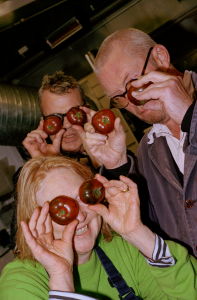Master barrel maker Alastair Simms speaks with Clare Finney about the history, skill and significance of his craft at his Yorkshire-based cooperage
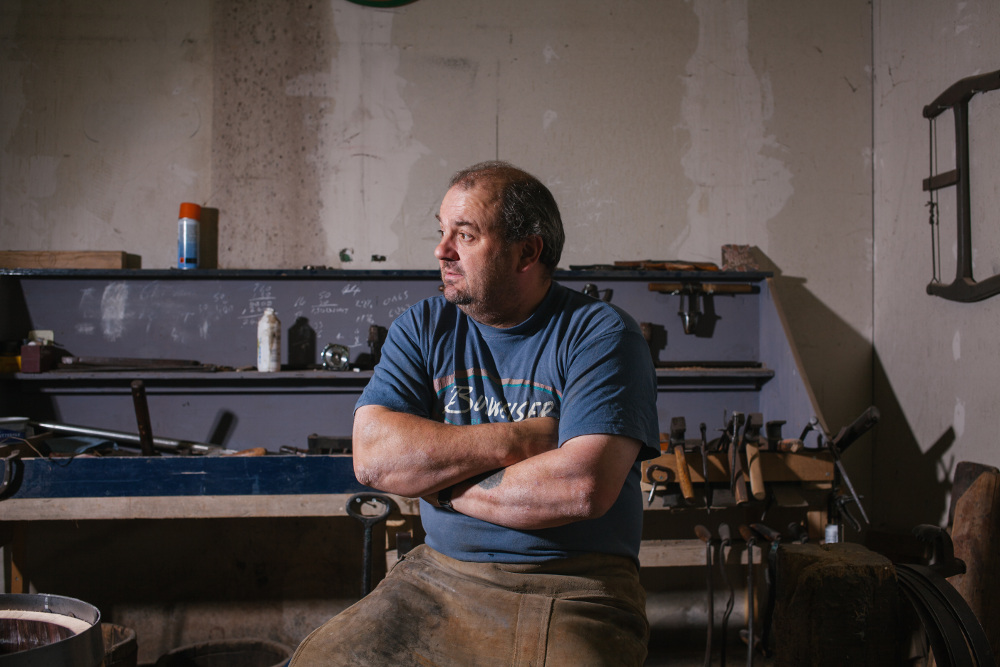
In November 1983, a young Alastair Simms was placed in the barrel he had just made, doused in water, and covered in a ‘muck’ of soot, feathers, shavings, beer and treacle. The outside of his barrel was then hammered by a dozen strong-armed coopers and rolled around and around. They lifted him out, tossed him in the air three times while singing, then dumped him back in again, only for him to emerge a few seconds later to be christened a fully-fledged journeyman cooper. In otherwards, a practitioner of the ancient craft of barrel making.
Thirty-two years on, a framed black and white photograph captures that moment: a teenage lad, face masked in filth, beaming as he crawls out of a beer barrel. It was, Simms confirms, a momentous day. “The initiation ceremony’s called ‘Trussing the Cooper’,” he says proudly, standing in his own cooperage White Rose in North Yorkshire, England. “It’s not changed since the 14th century.” Needless to say, it makes the rugby initiations at British universities look tame.
If becoming a cooper is a feat in itself, remaining one in the 21st century is a triumph. Last time Alastair Simms approached the media, it was to sound the alarm bells for the death of the coopering trade. “There are only four breweries left who employ coopers in the country and I’m the only master,” he announced back in 2009. He’d trained an apprentice while working with Weston’s Brewery in the 1990s – hence the ‘master’ title – yet he was struggling to find a new protégé. “Coopering is a proper historic, old-fashioned trade and if you don’t have a skill with your hands from a very young age then you can’t learn it,” he continued. Without a 16-year-old apprentice prepared to stick with him for five years, the art of coopering would follow him to the grave.
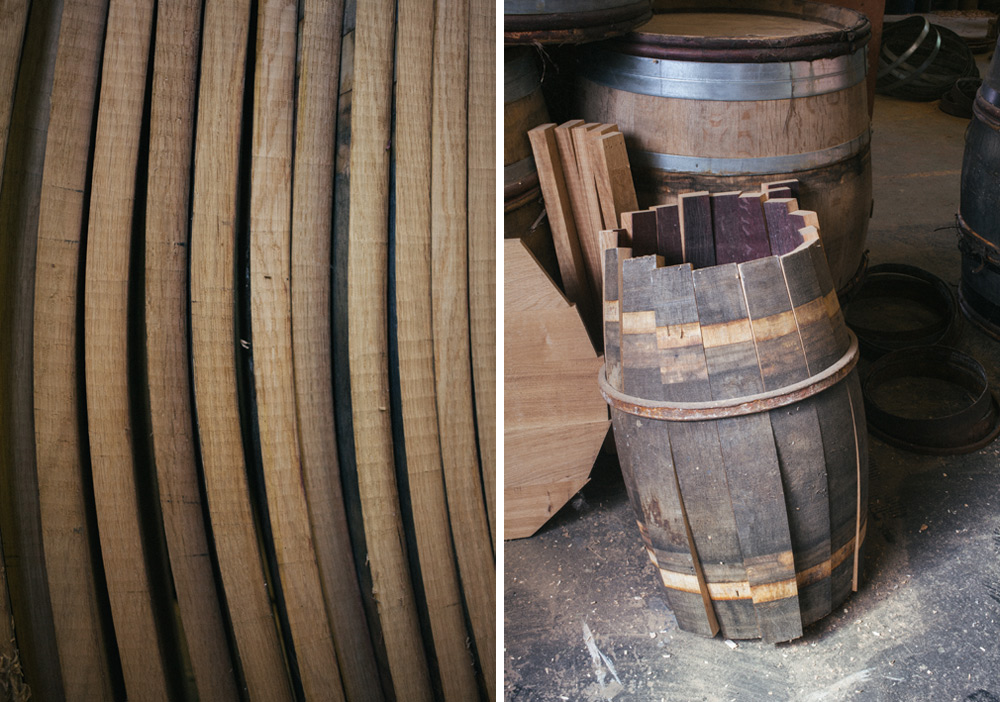
If becoming a cooper is a feat in itself, remaining one in the 21st century is a triumph.
Coopering in England has in fact been in decline since the 1960s, when brewers realised metal casks would be cheaper and less troublesome than using coopers. “We have always had this strained relationship with them,” says Simms, “ever since the Worshipful Coopers Company won the right to be independent from breweries in the 1500s.” Back in the day, a head cooper had more clout than a head brewer and “he got better paid, too,“ Simms claims. Converting from wood to metal, therefore, proved tempting for breweries even if it did rather compromise the flavour of the ale.
In 2009, the nation heard Simms’ call to arms and within two months he found himself besieged with applications. Alas, the then-government’s myopic stipulation that a trainee attend university as well scuppered the apprenticeship plan. “There’s no university for coopering,” Simms growls. “It gets in the way and teaches them the wrong things.” On the plus side, the situation gave Simms the publicity he needed to survive.
As English winemakers bloomed and the craft beer revolution continued, demand for wooden casks grew apace. “Really what we are seeing now is Victorian brewing all over again – I’ve got an agent in Northern Ireland and in the States,” he says, happily. “What matters to microbreweries these days is the beer’s taste, rather than producing huge quantities”. And, according to Simms, when it comes taste, wood wins every time.
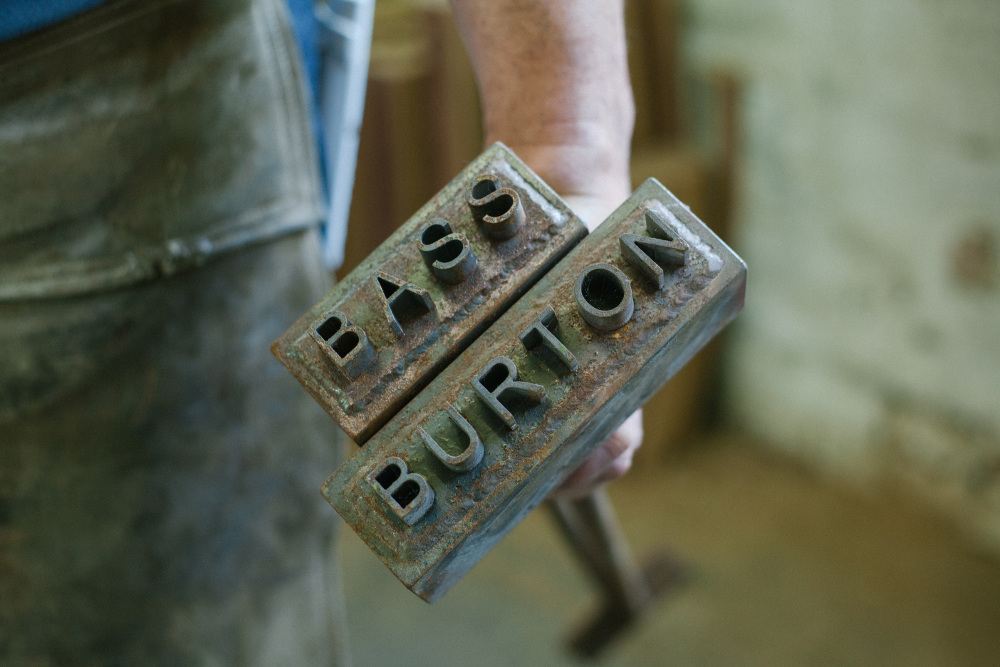
I ask if Simms can really taste the difference between ale from wooden casks versus ale from metal ones. “It’s night and day,” he says. “Wood takes the sharpness off and enhances the flavour of the ale.” Of course this, while by no means irrelevant, is not all that interests microbrewers these days.
“I’m being asked to do things now that as an apprentice I was told I could never, ever do,” he tells me, “like this for example.” He rolls a large wine barrel – or, to use the technical term for this size, ahogshead – over towards me. “If we take this apart, there’s enough timber to make a 36-gallon cask, and the brewers like that it will flavour the beer too.”
Beer into old wine casks, beer into old whisky casks, beer into old rum casks – if it once held alcohol, microbrewers will experiment with it. “I ask these chaps what they want, and I give it to them,” Simms shrugs, looking the faintest bit sceptical. Ten years ago such ventures were unplumbed depths for him as a cooper. These days, they’re his stock-in-trade, together with regular ale casks, churns and water butts for film sets, and English wine barrels – a small, yet potentially lucrative market, once our winemakers realise there’s an alternative to the French barrels closer to home.
The wine cask Simms is currently leaning on is not his own, but hails from France. From there, it was transported to New Zealand to be filled with the Kiwi’s finest Sauvignon Blanc. “The brewers are hoping that by using wood once used for white wine, it will enhance the flavour of the hops,” says Simms, rolling the empty barrel back into his workshop. Inside, there’s one he unmade earlier: its stripped, spare-looking wooden slats (called staves) are ready and waiting to be cut and resurrected into a ‘new’ ale cask.

“Recycling is what we’ve always done. There’s nothing new here,” Simms explains, tossing a large stave effortlessly up into his hand to inspect it. A hogshead is converted into a barrel and a barrel is recycled into a kilderkin, which in turn becomes a firkin – the most common container for an ale cask.
“By the time it finishes its life it could be a 4.5 litre gallon, and the timber would be between 115 and 180 years old,” he says. ‘Barrel’ is a common misnomer, I’m told. “It’s actually a unit of measurement. The generic term is a ‘cask’, though there are plenty of landlords make that mistake,” Simms laughs.
Tools unchanged in centuries send buttery curls of oak shavings flying from beneath Simms’ experienced hands as he reshapes the staves. No measuring is needed, as, after three decades, Simms judges by eye. “I normally play Black Sabbath at this point,” he shouts over the harsh barks of scraping wood, “or Sex Pistols if I’m feeling angry.” That done, he slots them into a metal ring at one end, and takes the half-made cask outside for the next stage: “New cuts need steaming, older cuts like this will bend after gentle heat.”
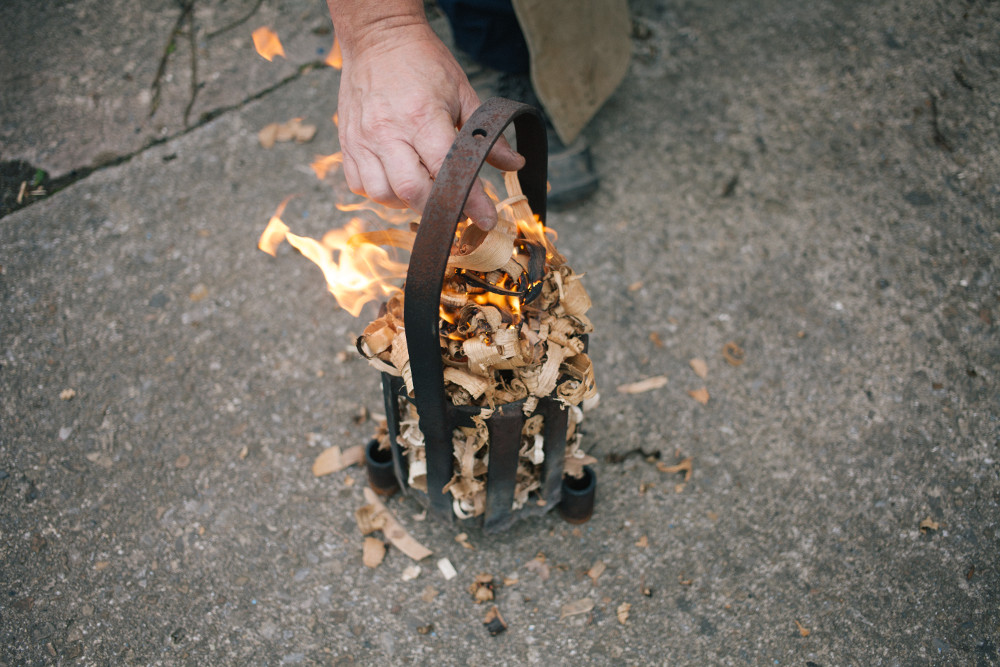
A fire is lit inside the cask without touching it, and a rich, sweet smell starts to seep out, creating white wine infused fumes. “The worst is whisky when you’ve a hangover – it makes your head spin.” When the staves are soft and warm to touch they can be bent into a second ring and left to cool. The finished cask needs no sealant or glue to bind it. “How do you test if the final cask water-tight?” I ask. “I don’t test it,” he replies with a smile and a shrug. “If it’s done right, it just is.”
Simms’ skill is self-evident, yet it’s not just his handiwork that has led him to spearhead this revival of coopering. After all, there are still four other coopers working in England today. What makes Simms special is that, aside from being the only master cooper in the country and a liveryman of the Worshipful Company of Coopers (now largely a charitable arm), he possesses an encyclopedic knowledge of the history of his trade. Indeed, he’s frequently found himself advising the historians.
His most recent commission saw him help with the filming of the Moby Dick adaptation, The Heart of the Sea. “Everything in those days on board a ship was stored in casks. The set directors and historians came to my workshop, saw some old, dirty barrels and said ‘those are perfect.’ I said, ‘they’re not, they’d be newly made in those days.’” In the end, Simms himself made nearly 200 casks for use in the film.
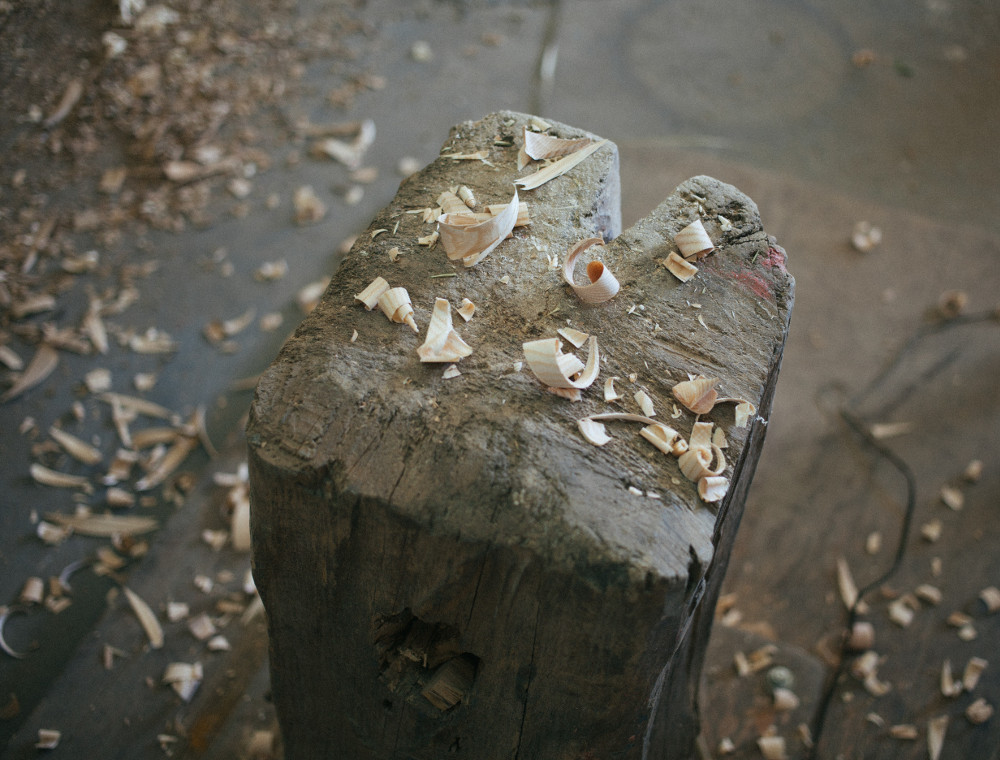
Still, working on the set of Moby Dick must have been fun, I ask. “It was alright. Pretty boring,” he says. “Chris Hemsworth was alright, though.” The film, due out in December 2015, actually shows Simms working the ‘cooperage’ aboard the Peqod. “Naval coopers had two names: jolly jack tars, or groggers, because when a rum barrel was empty they’d fill it with boiling water, roll them around the cooperage, then serve up the contents. That was called grog,” he says. “You’d have to be careful with that though. If it had wood alcohol mixed in it too, you could go blind.”
At this point, Simms stops talking, gnaws aggressively at his hand, then spits vehemently. “Splinter,” he says, “occupational hazard.”
He enjoys working for himself. He’s had his own cooperage for two years now, having been freelance at Wadworth’s Brewery before, but he’s looking forward to having an apprentice next year. “The Worshipful Company are trying to get me one,” he says. “They’re just waiting for funding now. My mate Camilla says to ask Charles about it.” Charles and Camilla as in the Charles and Camilla? I ask, taken aback. “The very same,” he replies. “She thinks he’ll be interested,” Simms adds, in the manner of a man who’s no stranger to the Royal Family. Sure enough, it transpires he’s met a lot of royalty on his mission to save coopering. “I’ve had a pint with Prince Philip,” Simms says. “He loves to hear about the craft – as does Her Majesty, in fact.”
Maybe it’s the whiskey odour, maybe it’s the Cooper’s Trussing, but Simms is not a man afraid to assert himself. The ‘wine-flavoured’ cask completed, we retreat back to his office for a pint of ale. It tastes… complex: malty, woody and warmly rich, having come from his personal cask.
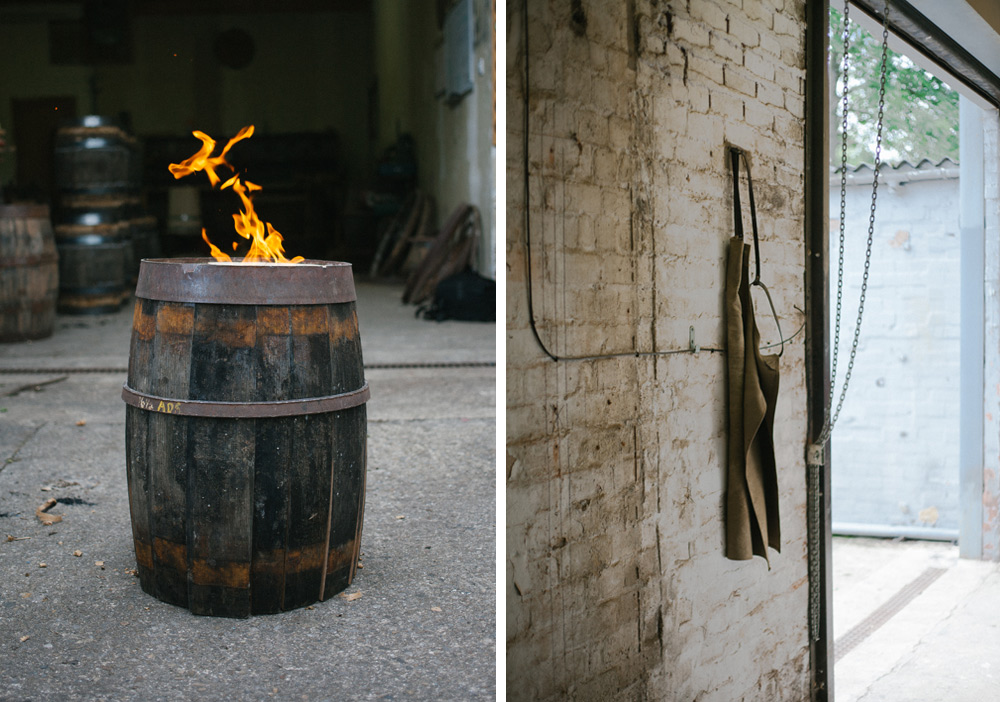
“When I was made a Freeman of the City of London they took me to the Lord Chamberlain court and gave me a drink of malmsey,” he says after a long, deep draught. “It’s part of the ceremony – and when I’d finished it I said, ‘I’ll have another of them, please’, he tells me. “The assistant said, ‘you can only have one’, but the Chamberlain knew better. ‘He knows his history,’ he said to us. I said to him, ‘Yes, I certainly do’. You see, the coopers bribed the court with half a butt of malmsey to secure their independence from brewers in the 1533. ‘We bought you malmsey,’ I said, ‘and I’ll have another please.’”
Simms raises his pint glass and I meet his with a cheers. The future of coopering might rest with this man, but if it does, it’s in safe hands.
Photography by Joseph Fox




